Objective: To evaluate Internet addiction among medical students in northeastern India and gain detailed knowledge about the prevalence, risk factors, and ill effects commonly associated with the disorder.
Method: The cross-sectional study sample comprised 188 medical students from Silchar Medical College and Hospital (Silchar, Assam, India). Students completed a sociodemographic form and an Internet use questionnaire, both created for this study, and the Young’s 20-Item Internet Addiction Test after they received brief instructions. Data were collected during a10-day period in June 2015.
Results: Of the 188 medical students, 46.8% were at increased risk of Internet addiction. Those who were found to be at increased risk had longer years of Internet exposure (P = .046) and always online status (P = .033). Also, among this group, the men were more prone to develop an online relationship. Excessive Internet usage also led to poor performance in college (P < .0001) and feeling moody, anxious, and depressed (P < .0001).
Conclusions: The ill effects of Internet addiction include withdrawal from real-life relationships, deterioration in academic activities, and a depressed and nervous mood. Internet use for nonacademic purposes is increasing among students, thus there is an immediate need for strict supervision and monitoring at the institutional level. The possibility of becoming addicted to the Internet should be emphasized to students and their parents through awareness campaigns so that interventions and restrictions can be implemented at the individual and family levels.
A Cross-Sectional Study on the Prevalence,
Risk Factors, and Ill Effects of Internet Addiction
Among Medical Students in Northeastern India
ABSTRACT
Objective: To evaluate Internet addiction among medical students in northeastern India and gain detailed knowledge about the prevalence, risk factors, and ill effects commonly associated with the disorder.
Method: The cross-sectional study sample comprised 188 medical students from Silchar Medical College and Hospital (Silchar, Assam, India). Students completed a sociodemographic form and an Internet use questionnaire, both created for this study, and the Young’s 20-Item Internet Addiction Test after they received brief instructions. Data were collected during a10-day period in June 2015.
Results: Of the 188 medical students, 46.8% were at increased risk of Internet addiction. Those who were found to be at increased risk had longer years of Internet exposure (P = .046) and always online status (P = .033). Also, among this group, the men were more prone to develop an online relationship. Excessive Internet usage also led to poor performance in college (P < .0001) and feeling moody, anxious, and depressed (P < .0001).
Conclusions: The ill effects of Internet addiction include withdrawal from real-life relationships, deterioration in academic activities, and a depressed and nervous mood. Internet use for nonacademic purposes is increasing among students, thus there is an immediate need for strict supervision and monitoring at the institutional level. The possibility of becoming addicted to the Internet should be emphasized to students and their parents through awareness campaigns so that interventions and restrictions can be implemented at the individual and family levels.
Prim Care Companion CNS Disord 2016;18(2):doi:10.4088/PCC.15m01909
© Copyright 2016 Physicians Postgraduate Press, Inc.
aDepartment of Psychiatry, Silchar Medical College and Hospital, Silchar, Assam, India
*Corresponding author: Subrata Naskar, MBBS, Room No 1, New PG Hostel, Silchar Medical College and Hospital, Silchar, Assam, India 788014
([email protected]).
Over the last decade, the Internet has become one of the most important tools of urban man—from information, job opportunities, and education to entertainment, including social media sites and networking—and is gradually becoming an integral part of our day-to-day life. With the advent of new-age smartphones, tablets, and computers, the Internet is readily accessible to the general population or “at the fingertips.” It has a tremendous effect on society and is leading to a very gradual but perceptible change in the cultural belief system as well as the concepts of morality and responsibility. The Internet can have a negative impact on youths and young adults in particular if it is not utilized in a controlled and proper way. According to the last census data (in 2011),1 the Indian population is approximately 1.2 billion, and in this exponentially growing population, youth and young adults occupy a significant number. It is estimated that in India, about 18 per 100 of the general population are active Internet users and most are young adults.2 So, as the Internet grows, the vices do as well, and there is increasing concern worldwide with regard to what has been labeled Internet addiction.
In 1995, Ivan Goldberg, MD, first proposed the term Internet addiction in a satirical hoax, which soon became popular.3 Since then, numerous terms have been used to describe this problem such as Internet overuse, problematic computer use, pathological computer use, iDisorder, etc. Internet addiction is the inability to control one’s use of the Internet, which causes marked distress and leads to functional impairment in various domains of life—social, familial, and individual. It can affect occupational and academic achievement and may cause psychological and physical problems as shown by numerous studies4–7 conducted globally. Internet addiction is defined as “a psychological dependence on the Internet, regardless of the type of activity once logged on.”8(p12) Initially, Young9 developed an 8-item diagnostic questionnaire (questions were asked on preoccupation with Internet use, investment of increasing amount of time, repeated unsuccessful effort to cut down, mood symptoms on cutting down use, staying online longer than intended, jeopardized personal or occupational life, concealment of extent of involvement in the Internet to others, and whether the Internet was used as an escape) and defined Internet addicts as those with 5 positive responses. Later, Young developed a 20-item questionnaire, Young’s 20-Item Internet Addiction Test, wherein persons with a score of 80–100 with significant life impairment were regarded as addicts. This 20-item questionnaire was used in our study.
Greenfield’s10 study on Internet addiction showed that the prevalence of Internet addiction is about 6% of the world’s general population, whereas Scherer11 found that 14% of the college population are addicted. Young9 proposed that Internet addiction is closely related to impulse control disorder as presented in the DSM-IV. To date, the disorder is not recognized as an individual entity; the DSM-5 states the need for further research. Significant focus is currently being given to this problem worldwide, and studies are underway to determine the probable sociodemographic variables and risk factors leading to Internet addiction, as well as its effects. However, in India, the number of studies regarding this issue are limited, more so in northeastern India. This article is an attempt to evaluate Internet addiction among young adults in northeastern India and gain detailed information about the prevalence, pattern, risk factors, and ill effects commonly associated with the disorder.
METHOD
This study was conducted at Silchar Medical College and Hospital, Silchar, Assam, a state in the northeastern part of India, among the medical undergraduate and postgraduate students. The study was conducted after obtaining approval from the institutional ethics committee. A semistructured form containing various sociodemographic variables and an Internet use questionnaire were distributed to the students along with the Young’s 20-Item Internet Addiction Test. Data were collected during a 10-day period in June 2015. The questionnaire and scale were filled out anonymously, and students were asked to place them in an unnamed envelope to avoid any bias. Confidentiality was strictly maintained throughout the study.
Data Collection Tools
Sociodemographic form. A sociodemographic form was created and standardized in the Department of Psychiatry, Silchar Medical College, to collect the required sociodemographic data.
Internet use questionnaire. This open-ended questionnaire was created and standardized in the Department of Psychiatry, Silchar Medical College, to obtain data on the pattern of Internet use. This questionnaire was previously implemented in a pilot study conducted in this institution with 40 medical students and was found to be a reliable data-collection tool. The questionnaire provides information on years of computer use, years of Internet use, hours of Internet use per day, expenditure on the Internet per month in Indian rupees, most used gadget, login status (always online, occasionally checks in, infrequently checks in), most common way of using the Internet (mobile Internet, Wi-Fi, data card), time spent by parents and siblings online (to see the family approach and acceptance toward Internet use), and most accessed content when online (social networking site, social media, academic materials, downloadable media, pornography).
Young’s 20-Item Internet Addiction Test. This test has been used globally for evaluation of Internet addiction, and its validity and internal consistency reliability have been well documented.12,13 This 20-item questionnaire is answered on a 5-point Likert scale, which evaluates the degree to which Internet use affects a person’s social life, sleep, academic activity, interpersonal relationships, and emotions. The test’s 20 questions are answered using a severity rating of 1 (rarely) to 5 (always), and the total score is calculated by adding all of the individual question scores. The total score represents the level of addiction and provides information about the ill effects of Internet addiction in different domains of life.
Score Interpretation
1. 80–100: Internet usage is causing significant problems in the user’s life. The user should evaluate the impact of the Internet on life and address the problems directly caused by Internet usage.
2. 50–79: The user is experiencing occasional or frequent problems because of the Internet.
3. 20–49: The user may surf the Internet a bit too long at times but has control over usage.
Those subjects with a score of 80–100 were considered addicts, 50–79 possible addicts, and 20–49 average users. We introduced a new category, less than average users, for those who scored less than 20 (0–19) to obtain data on those who use the Internet much less than the average population. The terms addict, possible addict, and less than average user were not included in the original scale.
Statistical Analysis
Data analysis was conducted with SPSS version 22 (IBM, Armonk, New York). The sociodemographic data and details regarding pattern of Internet use were tabulated. The prevalence of Internet addiction among the study subjects is shown as a percentage. Descriptive statistics were used to examine the association between risk factors and addiction. Chi-square or Fisher exact tests were applied wherever applicable; P values < .05 were considered significant in all calculations.
RESULTS
A total of 188 medical students who were studying at different levels of undergraduate and postgraduate medical courses were included, of whom 114 (60.6%) were male and 74 (39.4%) were female. Most students were in the age group of 18–20 years (43.1%); however, the mean ± SD age for the total sample was 22.51 ± 2.91 years. Of the 188 students, 169 (89.9%) were enrolled in undergraduate courses, while 19 (10.1%) were in postgraduate degree/diploma courses. The majority of the students were Hindu: 121 (64.4%), followed by Muslim: 52 (27.7%), Christian: 13 (6.9%), and other: 2 (1.1%). Most of the students (91.5%, n = 172) received education in English at school, while 8.5% (n = 16) received education in their respective regional language (Assamese, Bengali, Manipuri). The sociodemographic variables and some important Internet use–related data are tabulated in Table 1, which shows that many of the study subjects had used the computer for 5–8 years (n = 69, 36.7%), while most had used the Internet for 3–6 years (n = 79, 42.0%). Most students spent 200–400 rupees/mo on the Internet (n = 78, 41.5%), followed by less than 200 rupees/mo (n = 57, 30.3%), and the most common gadget used was the smartphone (n = 142, 75.5%).
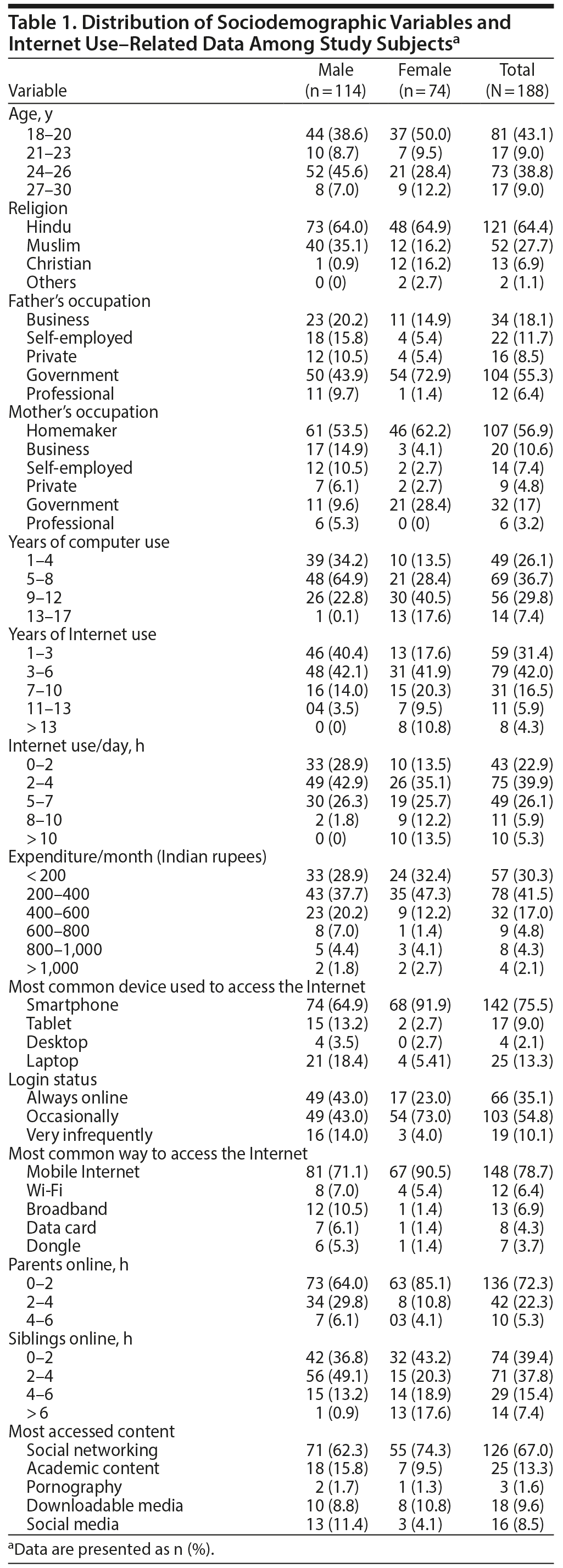
Of the respondents, 54.8% said that they were occasionally online, while 35.1% said that they were always online at any point of time of the day; the most common form of access was via mobile Internet (78.7%). The most accessed content was social networking (n = 126, 67.0%), followed by academic content (n = 25, 13.3%), downloadable media (n = 18, 9.6%), social media (n = 16, 8.5%), and, finally, pornography (n = 3, 1.6%). Many students said that their parents (27.6%) and siblings (60.6%) were also online more than 2 hours/d.
The results of the Young’s Internet Addiction Test showed that although only 1 student was an addict (0.5%), 46.3% (n = 87) were possible addicts, 44.2% (n = 83) were average online users, and 9% (n = 17) used the Internet less than the average users (Table 2). Since we found only 1 student to be an addict, for convenience, we merged the addicts and possible addicts together as an increased-risk group (n = 88, 46.8%) and the average and less than average users as a low-risk group (n = 100, 53.1%).
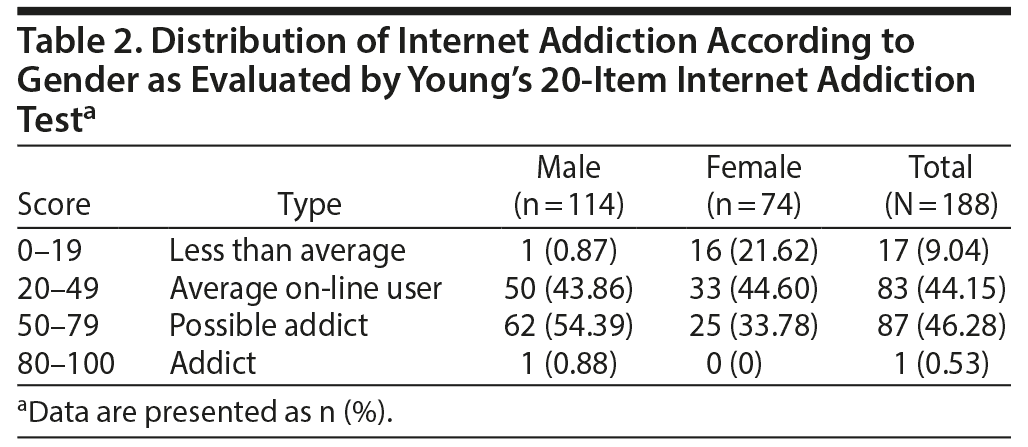
Using the Young’s Internet Addiction Test, we evaluated 3 specific psychological domains among the Internet users, namely formation of online relationship, effect on emotions (depressed/anxious), and the deleterious effect on academic performance. We compared the distribution of data in these 3 domains across both genders, as shown in Table 3. Table 4 shows the comparative data of the 2 groups (increased risk vs low risk) regarding the pattern, ill effects, and gender difference of the Internet use. We found that most of the increased-risk group members were male (P = .0045, odds ratio [OR] = 2.42, 95% CI = 1.319–4.443). There was a significant statistical correlation between those in the increased-risk group and those who preferred to always stay online (P = .0330). We also found a statistically significant correlation (P = .0466) between those in the increased-risk group and those who were exposed to the Internet for 6 years or more. Of the total subjects, 64 (34%) had a preference or history of forming online relationships, and among those, 48 belonged to the increased-risk group (ie, 54% of the increased-risk group). A strong association was present between students in the increased-risk group and those forming online relationships, which was statistically significant (P < .0001, OR = 6.30, 95% CI = 3.192–12.430). Thirty-nine of 63 male students who were at increased risk (61.9%) preferred online relationships, whereas only 36% of their female counterparts had such a preference. Seventy-six students (40.4%) had poor performance at college, and their grades and academic work suffered because of Internet addiction (P < .0001), and 64 students (34%) reported feeling depressed, moody, or nervous when not online (P < .0001, Figure 1). A highly significant statistical correlation was found between these findings and the increased-risk group (P < .0001).
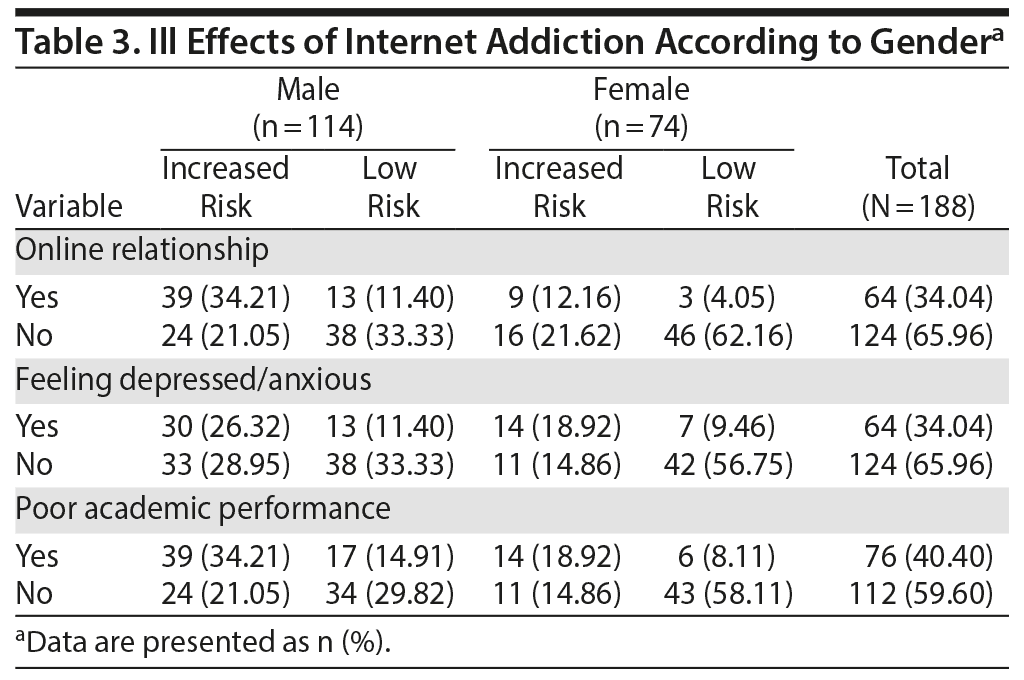
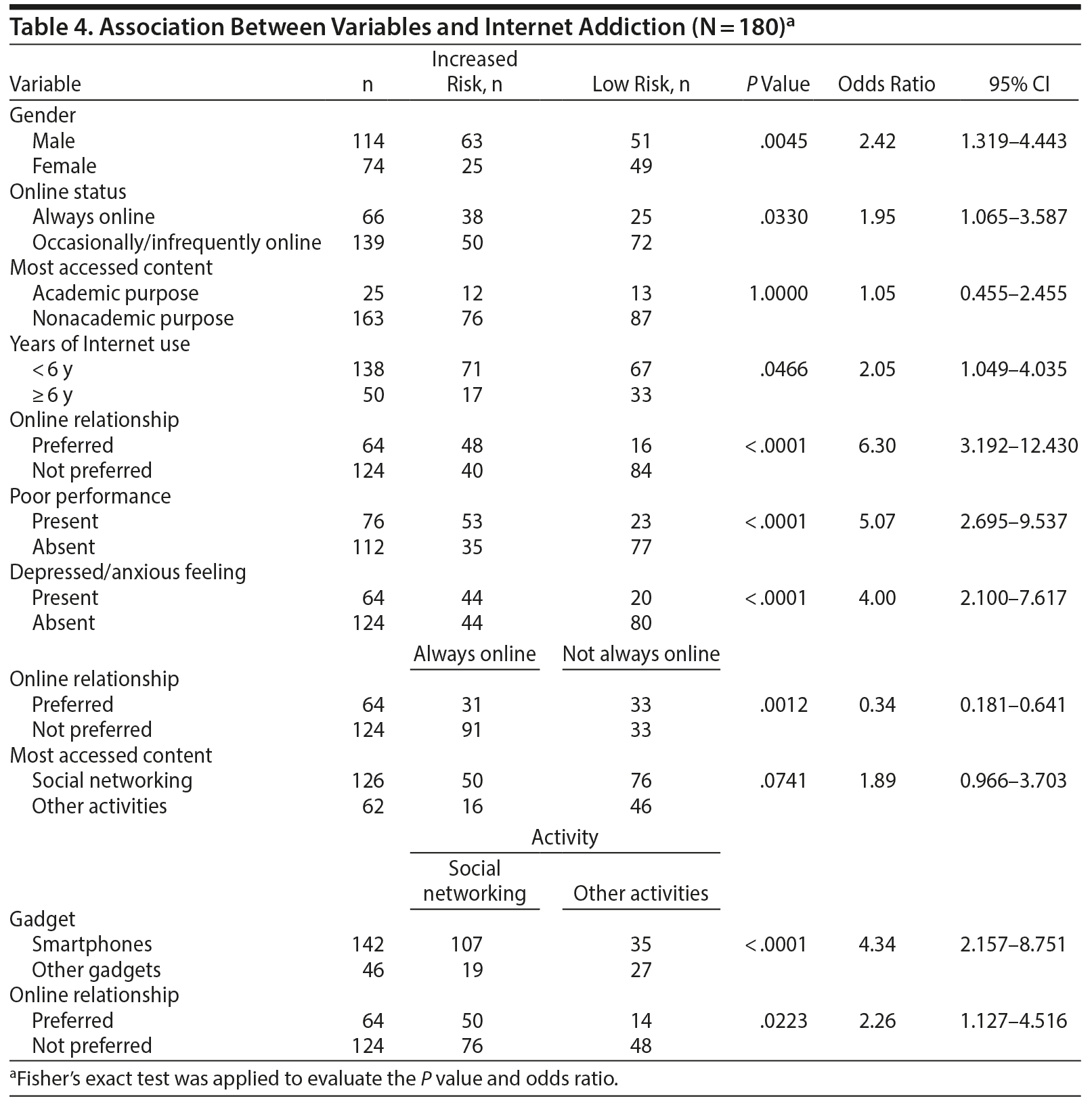
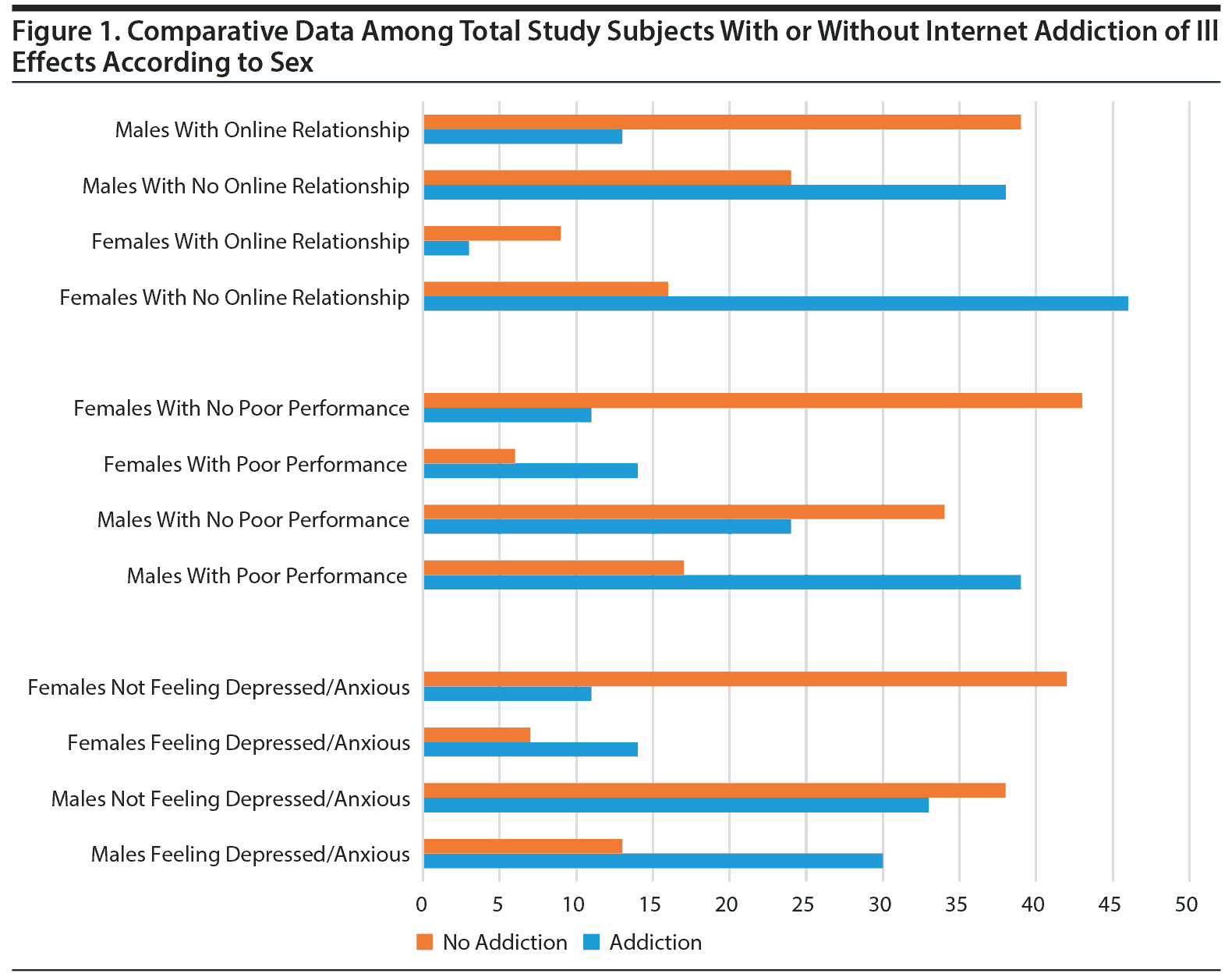
Table 4 also shows the association of various variables with online status of the user and Internet activity. We found that students who mostly use smartphones are more into social networking (P < .0001, OR = 4.34, 95% CI = 2.157–8.751). Also, those who access social networking sites more often are more prone to get into online friendships and relationships (P = .0223), and those who prefer online relationships mostly remain always online (P = .0012).
DISCUSSION
Studies are currently being conducted across the world to find the prevalence and effects of Internet addiction among the adolescent and young adult population. In this study, we aimed to find the prevalence, risk factors, and ill effects of Internet addiction among medical students in northeastern India. In our study, by application of proper statistical methods, we identified the variables that were highly associated with addiction to the Internet: permanent login status, male gender, exposure to the Internet for more than 6 years, urge to get into new online relationships, and using the Internet for nonacademic assignments and to get rid of feelings of loneliness and depression. We found that more than one-third of the students had been using a computer for > 9 years, and almost 25% had been using the Internet for > 7 years, which shows that a large number of students started using a computer and the Internet at an early adolescent stage. We also found out that almost one-third of students reported that their parents as well as siblings were using the Internet regularly for long hours (2–6 hours).
Although our study estimated the prevalence of Internet addiction to be only 0.5% among the medical students, which is in accordance with studies by Goel et al14 (0.7%) and Chakraborty et al15 (0.3%–38%), the number of students who might be possible addicts is significantly high (46.3%). These possible addicts constituted a major portion of our increased-risk group. We also found that Internet addiction was more common in males compared to females, which correlates with the study conducted by Niemz et al.16 Our study shows that the students who were at increased risk had an always online login status. There was also a strong relation between the increased-risk group members and their formation of online relationships, which was found to be more prevalent among the male population, a finding corroborated by Krishnamurthy and Chetlapalli,17 who found that withdrawal from significant real-life relationships may be a consequence of pathological Internet use. College students are more susceptible to be involved in online friendships, which eventually develop into online relationships. Krishnamurthy and Chetlapalli17 found that this behavior can be explained by the fact that at this time, there is a lack of proper parental supervision, unlimited access to the Internet on college campuses, and an ample availability of time; this behavior also may be due to the psychological and developmental characteristics of young adulthood or a way to get rid of stress.
Our study also showed that 34.4% of the increased-risk group reported being depressed, moody, and nervous when not online; similar findings were found by Dong et al,18 who reported that “significantly higher scores were observed for dimensions on depression, anxiety, hostility, interpersonal sensitivity, and psychoticism, suggesting that these were outcomes of Internet addiction disorder.”(p1) Ceyhan and Ceyhan,19 in their study of Turkish university students, reported that loneliness and depression were significant predictors of problematic Internet use. On the other hand, Goel et al14 reported high scores on anxiety and depression scales among Indian adolescents with excessive Internet use. Yadav et al20 found a strong positive association between Internet addiction and depression, anxiety, and stress. Cash et al21 addressed these findings and stated that there is always a debate about which came first, the addiction or the co-occurring disorder. In our study, poor academic performance was reported in 40.4% of the students, which was statistically significant (P < .0001). As mentioned by Young,9 an online survey22 and 2 campus-wide surveys conducted at the University of Texas at Austin11 and Bryant College23 have documented similar findings: that pathological Internet use is problematic for academic performance.
We found that students who mostly used smartphones were more into social networking (P < .0001, OR = 4.34, 95% CI = 2.157–8.751). Those who accessed social networking sites more often were prone to become involved in online friendships and relationships (P = .0223), and those students who preferred online relationships mostly remained always online (P = .0012). Also, a large number of medical students (86.7%) were using the Internet mainly for nonacademic purposes (social networking, downloading media) instead of academic activities. In a study of college students in south India by Arun et al,24 it was found that mild and moderate Internet addicts are mostly using the Internet for social networking (68.2%). Goel et al14 found that the purpose of using the Internet in addicts was significantly different from nonaddicts. Addicts were found to indulge more in nonacademic activities like social networking, gaming, and downloading media. In our study, a significantly smaller number of students (1.6%) reported that they use the Internet to access pornographic material. This finding, however, goes against the estimated prevalence of pornographic addiction among adolescents and young adults.25 Our finding may be due to social desirability bias. The possible explanation may be that, in spite of proper explanation and application of methods to maintain confidentiality, the students still desired to portray themselves in a good light or maybe they were hesitant about admitting that they were using the Internet for viewing pornographic materials.
CONCLUSION
We have found that male gender, permanent login status, urge to get in an online friendship or relationship, long years of exposure to the Internet starting in early adolescence, and using the Internet for nonacademic activities were strongly associated with Internet addiction. The ill effects of Internet addiction include withdrawal from real-life relationships, deterioration in academic activities, and a depressed and nervous mood. Although only 0.5% of the study participants were found to be Internet addicts, we found a high number of students in the category of possible addicts (46.3%), which is alarming, as with increasing and uncontrolled Internet use they may progress to an addictive state in the near future and thus are at an increased risk. This study also reflects the fact that Internet use for nonacademic purposes is increasing among students over time, so there is an immediate need for strict supervision and monitoring at least at the institutional level. The possibility of becoming addicted to the Internet should be emphasized to students and their parents through awareness campaigns so that interventions and restrictions can be implemented at the individual and family levels.
Submitted: November 19, 2015; accepted January 19, 2016.
Published online: March 31, 2016.
Potential conflicts of interest: None reported.
Funding/support: None reported.
Acknowledgments: The authors thank the undergraduate and postgraduate students who participated in this study for their kind cooperation.
REFERENCES
1. Census 2011. 2011. http://www.census2011.co.in/. Accessed November 2, 2015.
2. Internet users (per 100 people). 2015. http://data.worldbank.org/indicator/it.net.user.p2. Accessed November 2, 2015.
3. Miller P. Principles of Addiction: Comprehensive Addictive Behaviors and Disorders, Volume 1. Cambridge, MA: Academic Press; 2013.
4. Black DW, Belsare G, Schlosser S. Clinical features, psychiatric comorbidity, and health-related quality of life in persons reporting compulsive computer use behavior. J Clin Psychiatry. 1999;60(12):839–844. doi:10.4088/JCP.v60n1206 PubMed
5. Shapira NA, Goldsmith TD, Keck PE Jr, et al. Psychiatric features of individuals with problematic Internet use. J Affect Disord. 2000;57(1–3):267–272. doi:10.1016/S0165-0327(99)00107-X PubMed
6. Kraut R, Patterson M, Lundmark V, et al. Internet paradox: a social technology that reduces social involvement and psychological well-being? Am Psychol. 1998;53(9):1017–1031. doi:10.1037/0003-066X.53.9.1017 PubMed
7. Young KS, Rodgers RC. The relationship between depression and Internet addiction. Cyberpsychol Behav. 1998;1(1):25–28. doi:10.1089/cpb.1998.1.25
8. Kandell JJ. Internet addiction on campus: the vulnerability of college students. Cyberpsychol Behav. 1998;1(1):11–17. doi:10.1089/cpb.1998.1.11
9. Young K. Internet addiction: the emergence of a new clinical disorder. Cyberpsychol Behav. 1998;1(3):237–244. doi:10.1089/cpb.1998.1.237
10. Greenfield DN. Psychological characteristics of compulsive Internet use: a preliminary analysis. Cyberpsychol Behav. 1999;2(5):403–412. doi:10.1089/cpb.1999.2.403 PubMed
11. Scherer K. College life online: healthy and unhealthy Internet use. J Coll Student Dev. 1997;38(6):655–665.
12. Widyanto L, McMurran M. The psychometric properties of the Internet Addiction Test. Cyberpsychol Behav. 2004;7(4):443–450. doi:10.1089/cpb.2004.7.443 PubMed
13. Lai CM, Mak KK, Watanabe H, et al. Psychometric properties of the Internet Addiction Test in Chinese adolescents. J Pediatr Psychol. 2013;38(7):794–807. doi:10.1093/jpepsy/jst022 PubMed
14. Goel D, Subramanyam A, Kamath R. A study on the prevalence of Internet addiction and its association with psychopathology in Indian adolescents. Indian J Psychiatry. 2013;55(2):140–143. doi:10.4103/0019-5545.111451 PubMed
15. Chakraborty K, Basu D, Vijaya Kumar KG. Internet addiction: consensus, controversies, and the way ahead. East Asian Arch Psychiatry. 2010;20(3):123–132. PubMed
16. Niemz K, Griffiths M, Banyard P. Prevalence of pathological Internet use among university students and correlations with self-esteem, the General Health Questionnaire (GHQ), and disinhibition. Cyberpsychol Behav. 2005;8(6):562–570. doi:10.1089/cpb.2005.8.562 PubMed
17. Krishnamurthy S, Chetlapalli SK. Internet addiction: prevalence and risk factors: a cross-sectional study among college students in Bengaluru, the Silicon Valley of India. Indian J Public Health. 2015;59(2):115–121. doi:10.4103/0019-557X.157531 PubMed
18. Dong G, Lu Q, Zhou H, et al. Precursor or sequela: pathological disorders in people with Internet addiction disorder. PLoS ONE. 2011;6(2):e14703. doi:10.1371/journal.pone.0014703 PubMed
19. Ceyhan AA, Ceyhan E. Loneliness, depression, and computer self-efficacy as predictors of problematic Internet use. Cyberpsychol Behav. 2008;11(6):699–701. doi:10.1089/cpb.2007.0255 PubMed
20. Yadav P, Banwari G, Parmar C, et al. Internet addiction and its correlates among high school students: a preliminary study from Ahmedabad, India. Asian J Psychiatr. 2013;6(6):500–505. doi:10.1016/j.ajp.2013.06.004 PubMed
21. Cash H, Rae CD, Steel AH, et al. Internet addiction: a brief summary of research and practice. Curr Psychiatry Rev. 2012;8(4):292–298. doi:10.2174/157340012803520513 PubMed
22. Brenner V. The results of an online survey for the first thirty days. 105th Annual Meeting of the American Psychological Association. August 18, 1997; Chicago, IL.
23. Morahan-Martin J. Incidence and correlates of pathological Internet use. 105th Annual Meeting of the American Psychological Association. August 18, 1997; Chicago, IL.
24. Vijay Paul RA, Ganapthi C, Duraimurugan K, et al. Internet addiction and associated factors: a study among college students in south India. Innov J Med Heal Sci. 2015;5(3):121–125.
25. Luder M-T, Pittet I, Berchtold A, et al. Associations between online pornography and sexual behavior among adolescents: myth or reality? Arch Sex Behav. 2011;40(5):1027–1035. doi:10.1007/s10508-010-9714-0 PubMed
Please sign in or purchase this PDF for $40.00.

